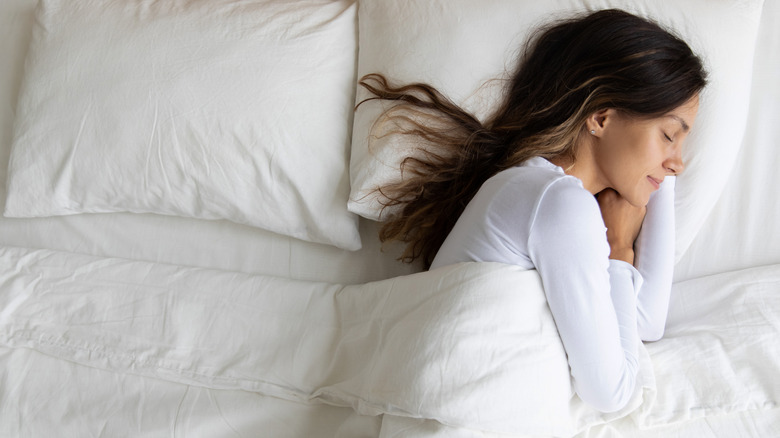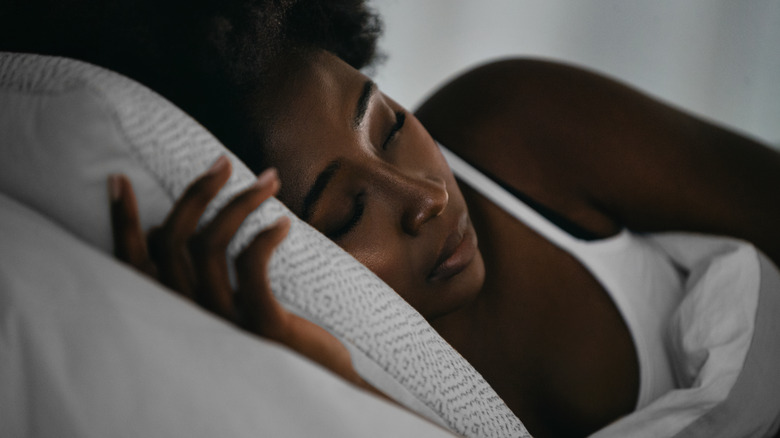Try This Humming Trick Next Time You Have Trouble Falling Asleep
We may receive a commission on purchases made from links.
Trying to fall asleep when you're struggling to do so is one of the worst feelings. Your mind is full of thoughts that you're trying to clear, you're tossing and turning, trying to get comfortable, and you keep your eyes closed hoping against hope that sleep will finally come.
The internet is full of tricks you need to try if you can't fall asleep at night. Humming like a bee is by far the most amusing one. Yes, we said humming ... like a bee. It seems the practice has its origins in yoga and the ancient Indian discipline of Ayurveda. Ayurveda wellness consultant and registered senior Akhanda yoga teacher, Alison Francis who calls herself "The Sleep Guru," wrote (via LinkedIn), "The vibration you create with the sound of the bumble bee is extremely relaxing for the brain, releases negative emotions, and stimulates serotonin." Francis, who also goes by the name, Anandi, calls it the "bumble bee breath". In yoga, it's called the "Bhramari Pranayama".
It is not uncommon to see babies humming in their sleep. Experts believe that this might be an effort to self-soothe. Looks like we can be learning something from infants if we can't get to sleep. So how does this humming like a bee thing work exactly?
Humming stimulates the pineal gland
The pineal gland is a part of your endocrine system that's responsible for secreting the sleep hormone, melatonin. "The pineal gland responds to vibration. Humming like a bumble bee creates a beautiful calming vibration to the nervous system and stimulates the pineal gland" which then releases melatonin, according to Alison Francis, per LinkedIn.
Dr. Chris Idzikowski refers to this breathing technique in his book, "The Expert Guide to Sleeping Well: Everything You Need to Know to Get a Good Night's Sleep". Idzikowski has talked of how not breathing properly at night can be a catalyst for sleep-related problems, so it's not hard to see why humming can make you focus on your breath, and therefore aid sleep. Bhramari Pranayama is only just one kind of deep breathing exercise that's employed for better sleep. Per, The Sleep Foundation, there's more: belly breathing, 4-7-8 breathing, and box breathing. Interested in doing some insect-like breathing if you can't fall asleep at night?
Here's how you can try the 'bumblebee breath'
Alison Francis instructed anyone interested in employing this trick to "turn the lights out, lie down comfortably on your back and make a bumblebee sound for 10 minutes. Just inhale and hum on the exhale" (via Saga Exceptional).
If you really want to reap the benefits of this yoga practice, make it a part of a complete sleep time ritual, as recommended by Francis (per LinkedIn). Grab some chamomile tea and sip it in silence as you prepare for bed.
"When you come back to bed, keep the lights low, so that your body knows it is still night time," explained the yoga teacher, who was a chronic insomniac herself for 15 years before she found a way to sleep well. If it helps, incorporate some journaling time before you bring yourself to a sleeping position. Francis recommends trying the bumble bee breath after some shallow breathing and/or meditation, but if you're too tired for all of that, you don't have to. "Hum like a bumble bee for 21 breaths," she instructed. Be mindful, however, of practicing this humming trick if you're sharing the bed with someone. Sleep is important, yes, but so is being respectful of others who are trying to catch some zzzs.



